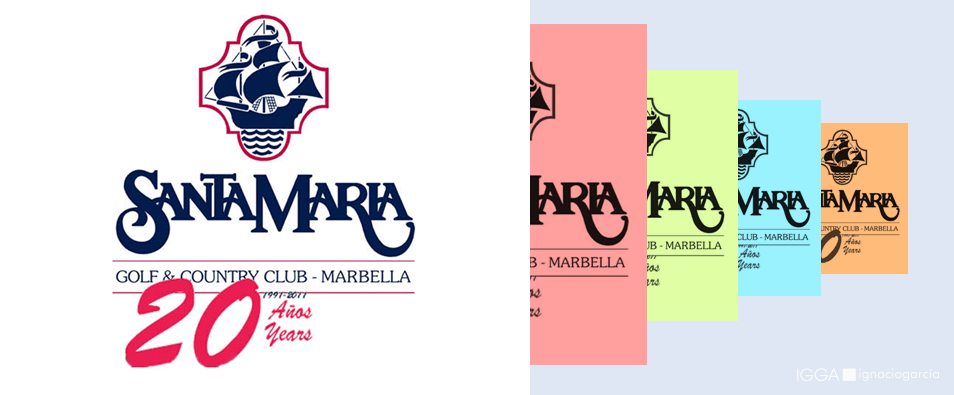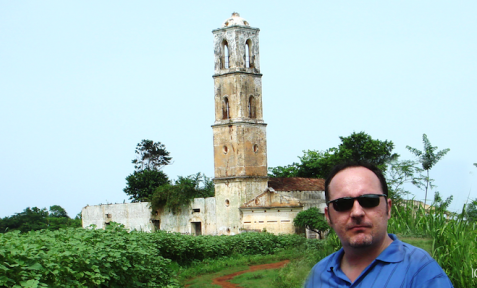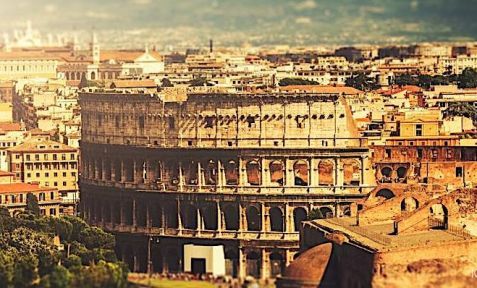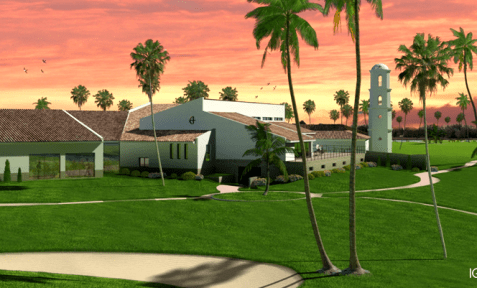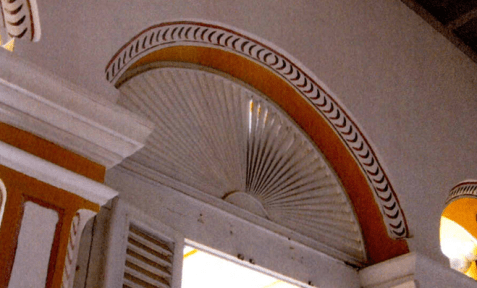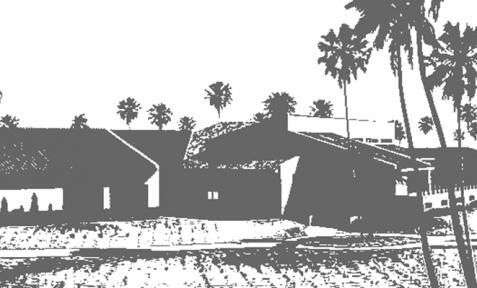Santa María Golf all began when a small group of golfers got their heads together and decided to look for land which was large enough for an 18-hole golf course and practice range and also large enough for a small residential development.
The group was headed by John Jenkins, a publisher, and Colin Mosely, a qualified engineer and designer with 25 years management experience.
Although the chosen site was considerably larger than intended, the site was considered to be particularly appealing, offering splendid views of mountains and sea and situated amongst dense pine and cork oak forests.
Access to the site from the N340 was excellent and perhaps the best along the coast. It was known that a new motorway network was planned and this would further enhance accessibility. Another major consideration was the fact that the project was in the municipality of Marbella and well served by international airports and only two and a half hours air travel from most European capitals.
Despite the existing large number of golf courses in the area, there remained a shortfall in supply and some green fees were excessively high, with some clubs not accepting group bookings.
The proliferation of time share developments was resulting in a higher market demand for golf. Equally there was a substantial increase in the non-British market participating in the sport. Previously the golf market had been dominated by the British. However, German, Scandinavian and Spanish players were beginning to create an important new market. The Andalucian tourist authority was encouraging golf course development in the area and they wanted to see at least 10 new courses on the Costa del Sol in the next five years.
It was known that 1992 would be an important year for Spain with full membership of the EEC, the Sevilla Expo, the Olympic Games in Barcelona and other activities which would stimulate the economy and attract international interest. At the time, market influences for the area were all positive and gave rise to confidence for the successful outcome of the company’s development plans. In early 1987, the Spanish wholly owned subsidiary Santa María Holdings S.A. was incorporated and the land purchase was completed.
In July 1989, initial planning approval for the entire scheme was granted by Marbella Town Hall. During this process, all the documents were revised to incorporate negotiated changes and the scheme was finally approved through the College of Architects.
During 1989 a company was formed to provide an ownership vehicle for golf shares to be sold to prospective golf club members. In 1991 Santa María Golf Club S.L., a Spanish company, was formed to lease the golf club and course from the group and provide a vehicle for the long-term operation of the club.
Style.
Some time ago, a well known ex-Ryder Cup player and famous TV golf commentator wrote:
“Here at Santa María Golf & Country Club I’m looking forward to watching and listening to people, admiring the views and enjoying the beauty and tranquillity without the hassle of trying to hole that three-footer. This really is a delight. The trees, the comfort, even the gentility which is something missing in life today. To be here and to enjoy it will be something very special. There are so many things to do and they all marry in beautifully – the Ryder Room, the Cotton Bar, the tennis and the bowls.
“I was brought up in a golfing atmosphere and one of the things I miss is the club life. When I was winning tournaments I was the professional at Parkstone overlooking Poole Harbour and one had to face the members. To be truthful, one did not love them at all. If you had done badly you always bumped into the wrong person. ‘Oh, I see you didn’t do very well…?’ They forgot athe times you did 68 and only remembered when you did 79. But that was all part of learning and growing up and listening to the tales and watching all the little nuances that went on in the clubhouse. The mild flirtation… the arguments with the steward… the fiery secretary… the slightly dozy golf pro… the green-keeper who knew every blade of grass on the course but did not have a mass of diplomas to prove that he knew his job. All those things seemed to fit into place so wonderfully well.
“But I think here at Santa María Golf & County Club there is an opportunity of recreating that lovely world which some people nowadays sadly think is gone. It is called – STYLE.
Yes, you guessed right: it was Peter Allis, one of the world’s best ambassadors for our game of golf.
These words were written more than 20 years ago so, what has happened?
Well a visit to Santa María will confirm these words and you will find the club to be one of the friendliest on the Coast. The aim was to maintain the family atmosphere that was created in the early days and to ensure that members still enjoyed coming to the club, either to play golf or for a drink and chat.
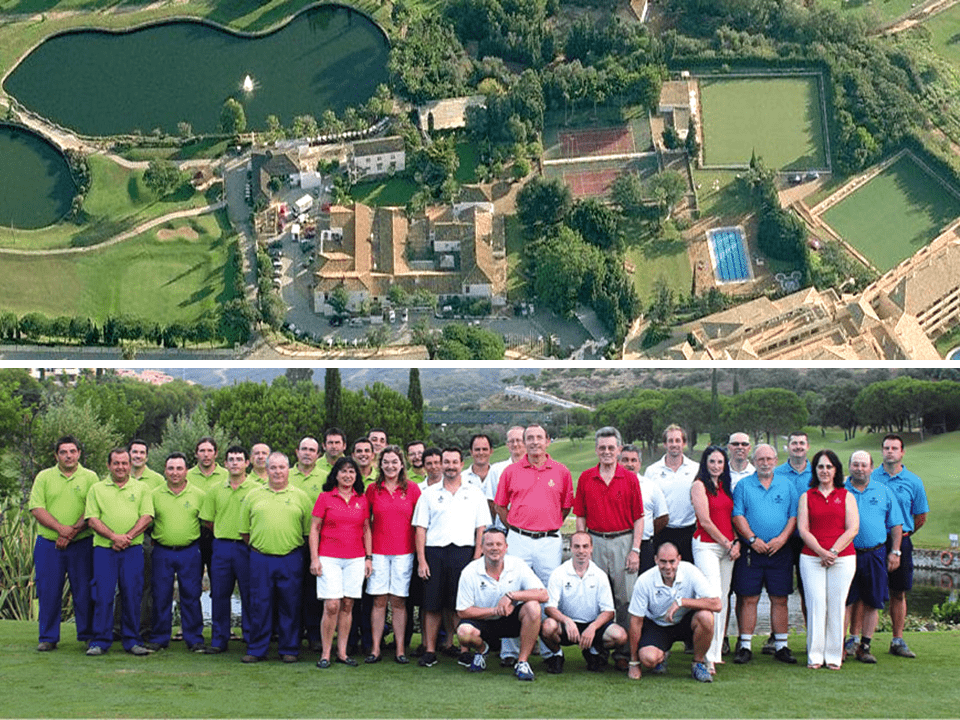 Santa María Golf has a truly international membership with 14 different nationalities. From the very beginning, the integration of members was encouraged by mixing people in some of the tournaments, particularly the Sunday Texas scrambles and stableford competitions. Members were mixed with visitors and so golfers met each other – they played, they talked and made friends – and that was and still is the essence of “Santa María”.
Santa María Golf has a truly international membership with 14 different nationalities. From the very beginning, the integration of members was encouraged by mixing people in some of the tournaments, particularly the Sunday Texas scrambles and stableford competitions. Members were mixed with visitors and so golfers met each other – they played, they talked and made friends – and that was and still is the essence of “Santa María”.
Colin Mosely has been the golf director at Santa María Golf & Country Club since its very inception and has seen it through the good and the difficult times. Although Colin is now semi-retired, he remains a director and works in a consultative capacity. The new golf director is Alfredo Ramiro Oregui, who is well known to the members. Alfredo has been the accountant for many years and continues to provide this service. We wish him all the best in his new role and we know he can rely on the support of key staff.
Problems and solutions.
In the early years, the company suffered badly from several forest fires. The first and worst of these happened in September 1987 and destroyed about 200 hectares. This occurred before the golf course was built so there was little protection. It is now recognised that a well irrigated golf course is the best form of fire break.
Other problems which have now been dealt with concerned damage caused by wild boar. The installation of electric perimeter fencing has proved successful, with no damage for the last five years.
Four projects which had a major impact on the golf course included the depuradora (sewage treatment plant), the removal of pylons and re-routing high tension power cables underground, the construction of the autopista (tollway) and the new bridge which provides the link between property to the east and west of the original golf course.
Construction of the depuradora caused few problems except for the occasional smell. Now that third stage treatment has been installed to purify the water, there is little or no smell and the growth of trees now serves to effectively camouflage the installation. The re-cycled water is mainly used for golf course irrigation, and eventually most golf courses will be obliged to use treated water.
The year 1998 was a difficult one for the golf course, and the maintenance staff were involved with abnormal work concerned with the autopista, the installation of new underground high tension cables across the golf course and various repair works associated with the real estate infrastructure build programme. All this diverted time that would normally be spent on golf course maintenance.
Construction of the autopista started in 1997. Three holes were affected by the work: i.e. the fifth, sixth and 15th and to a small extent the 14th.
The company was successful in winning a battle with the builders, Autopista del Sol, to have a tunnel of about 150 metres in length to minimise the visual and sound impact and to preserve the beauty of the environment. A great deal of planning was involved and, thankfully, there was no break in the continuous play of 18 holes. Satisfactory solutions were reached concerning the four holes affected, and the tees of the sixth and 15th were substantially increased in size.
The new bridge, 130 metres in length, linking the property to the east and west of the original golf course has proved a success with very little impact on golf and, like all good designs, it looks as if it has always been there.
Location.
Alongside one of Marbella’s best beaches, Santa María enjoys a privileged position within a beautiful natural environment. Only five minutes drive from the very heart of Marbella and the cosmopolitan Puerto Banús, it has easy access to the national road links and the international airports at Málaga and Gibraltar.
With only a short walk to the beach, past the convenient shopping centre at Elviria, the location is second to none.
Clubhouse.
The clubhouse is an impressive two-storey 19th century Spanish cortijo and is surrounded by extensive mature gardens. The outdoor facilities include two tennis hard courts, two practice putting greens, practice nets and swimming pools. Inside the main clubhouse are the administration offices, a billiards room with two full size tables, a large lounge area and a restaurant. The Ryder Restaurant is largely used for members’ functions.
In the last few years, a new restaurant has been built which overlooks the original nine-hole golf course, and a large and well stocked pro shop and caddy masters area has been created. The latest addition is a starters hut adjacent to the first tee.
Members.
The original intention was to have equal tee time availability between members and visitors paying green fees, and this objective still applies. The benefits available to members include peak tee times, club competitions normally on Wednesday and Sundays and league matches. There are 18 Honours Board competitions each year, with the club championship played over two days. Other benefits include social activities and organised away days to other golf venues. Dinner dances are held at Easter in conjunction with the 007 Cup sponsored by John and Maggie Armstrong, and other events take place on Captain’s Day and during the club championship. Also available are tennis, billiards, swimming, fitness room, sauna and restaurant discounts. Arrangements are being made to start bridge and interest has been shown by 40 members.
There are several membership options available including basic, unlimited and all-inclusive with buggy. The club’s PGA professional offers private or group coaching in English and Spanish and club repairs/re-gripping is also available.
The membership is represented by a hard-working committee who meet monthly with the exception of summer. The company has been fortunate to have had some very fine captains over the years and Terry Wills is no exception. Terry is spearheading junior golf with the help of other members of staff.
President´s Trophy.
In the early part of 2007, the president of Santa María, Abdulla Saudi, announced that he would like to see organised an annual event by invitation to thank all those people who had made a significant contribution to the growth and success of the club.
The first President’s Trophy competition took place on Saturday 20 October and 100 players comprising dignitaries of the town hall, past captains and committee, golf tour operators and long-standing club members were greeted with a goody bag containing many accessories, all with Santa María’s distinctive logo, a three-masted galleon. The course was immaculate and the weather perfect.
About 200 players and their partners were invited in the evening to the Don Carlos Hotel for cocktails followed by the prizing giving ceremony and a sumptuous five-course dinner.
The fifth President’s Trophy will take place on 8 October 2011 and will follow the same format as previous years with an individual stableford.
“Our quality is in our staff”.
Friend of King Juan Carlos, recipient of the Civil Merit Medal, successful banker… Libyan Abdulla Saudi is president of Santa María Golf & Country Club, the Marbella golf complex that this year celebrates its 20th anniversary.
–What are your memories of Santa María Golf when you first came here?
–Personally I became involved only in late 1997, not before that, but there was a group of investors who came during the early 1990s, to acquire this investment. They took it as a real estate project more than a golf course. Of course, as you know these real estate projects always need more than just apartments… they need good facilities, a golf course, other special features, etc. There used to be only nine holes when this was acquired, then another nine holes were added. We are very proud of the course because we have been able to maintain a good number of members as well as a lot of people who are using the golf course from time to time.
–What involvement did you have with golf before?
–I was chairman of Tripoli Golf Club from 1964 to 1970. It was the only main golf course at the time, though I didn’t start it up myself; I was just a member and then chairman. I was a basketball player and I was elected chairman of Tripoli Golf Club not because I was a golfer but because Tripoli Golf Club used to have two parts: the social side by the beach and the golf course. I was more active on the social side. When we held elections the social side defeated the golfers, and I was elected chairman. One day I went to the golf course and the pro, who was teaching some people, told me, “You’re the chairman and you don’t even know how to hit a ball with a golf club.” I told him I was more used to big balls, basketball, not trying to hit a small ball into a small hole. So he said, “Try it and see if you can hit it.” And instead of hitting the ball I was hitting the sand. So that’s how I got started in golf.
Since then my life has developed and changed a lot, especially after what happened in Libya. In the late ‘60s there was the Gaddafi revolution and he’s a guy who doesn’t believe in sports. The golf course land was distributed to military officers, so people could build their houses. I came to this part of Spain for the first time in 1974, when I started Aresbank. Then I also became president of Banco Atlántico. When I retired from the banking industry in 1995 I became associated with this group of investors here (at Santa María) as a partner. So, even though I am not a good player myself, I like to see good golf played. And that is why I have continued to support this project, in spite of the difficulties faced by the real estate industry and golf courses in these current times.
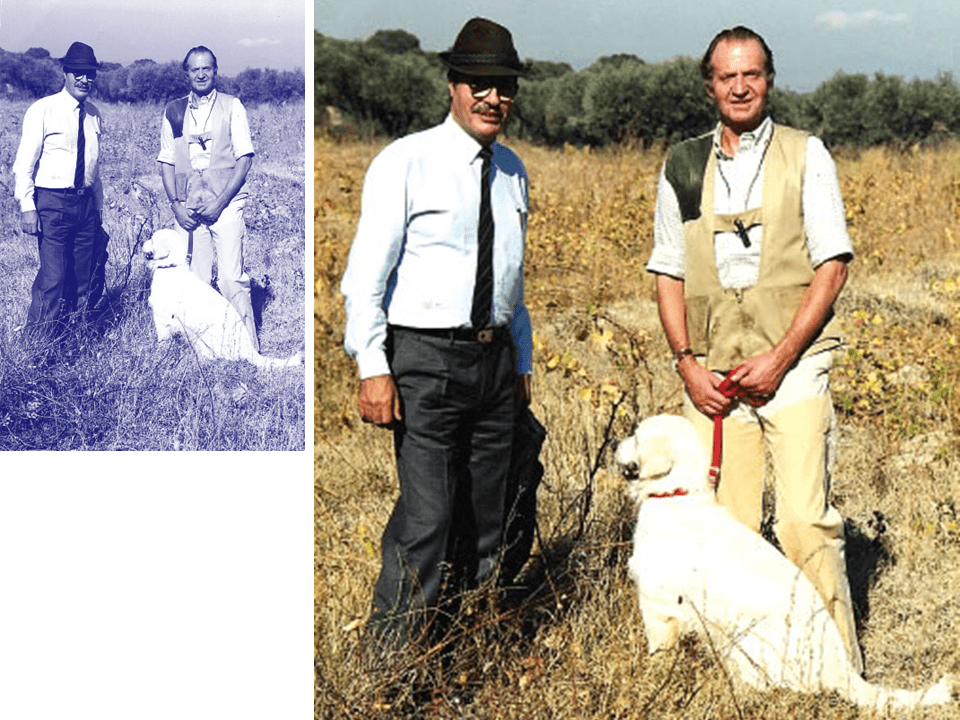 –What is Santa María Golf doing to get through the crisis?
–What is Santa María Golf doing to get through the crisis?
–From day one we were planning for the longer term. I believe in cycles, so in the good times we did not spend our money foolishly. We made some savings, and we used them to ensure the continuation and survival of the club. So far we are managing affairs well so we can still offer all those key things required by golfers: a very well maintained golf course, good staff, smiling faces – we have here what I like to call a small family. And I think so far we have been very successful.
–How long do you believe the crisis will last?
–We think the crisis may last another three years, not more than that. We think by then we’ll see a light at the end of the tunnel. We certainly hope so – we’re optimistic.
With what is going on it’s not only Spain that is suffering – it’s the whole world. It’s going through a real recession this time. Real problems that cannot be solved in a short period. So I think the situation will remain for a few years. I believe in what we call seven good years and seven hard years. It will not last longer than seven years. This time it’s already three or four years but this is a different situation. Spain’s a large country and enjoys great natural resources, so maybe it just needs better administration. What are the main elements of success for an economy? Here Spain is a good tourism country, has good agriculture, is a good industrial country to a certain extent, so all these sectors could make a very successful country once we have the proper management and the proper resources. But there are a lot of buts, not only here! Hopefully we will see more aggressive management in the years to come.
–What are Santa María’s strong points compared with other golf courses in the area?
–Our quality is in our staff. The golf course itself is also very well maintained.
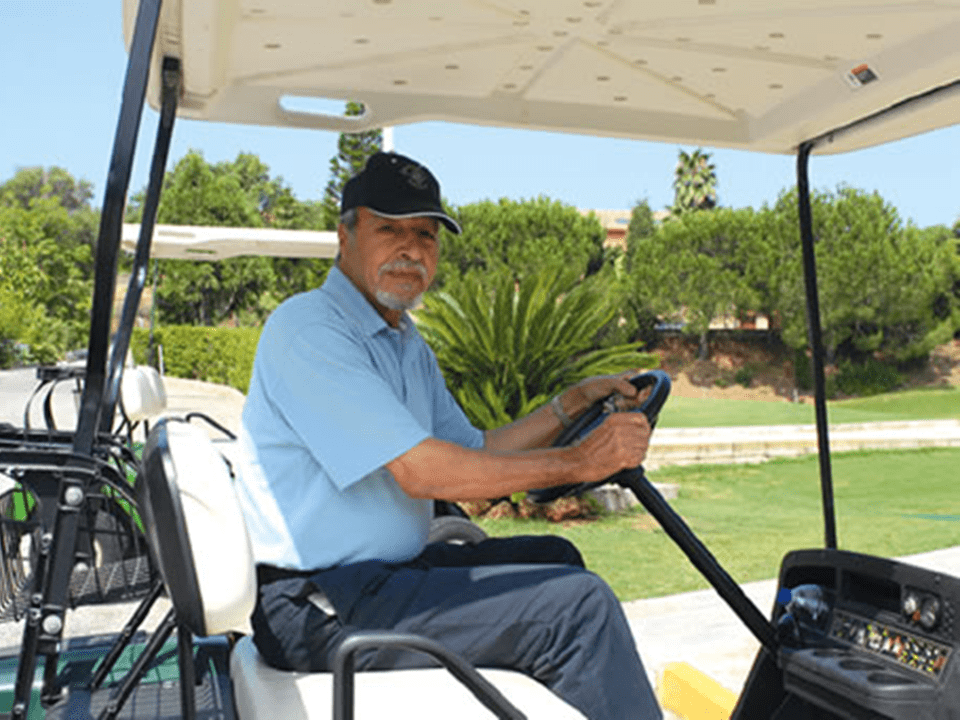
–What has been your main satisfaction as president of Santa María Golf?
–Satisfaction is not possible these days (laughing)! More accepting reality. From day one I have not looked at the golf course as a source of income. I look at it as one element supporting the whole project. As you know there is a holding company, Credoc, for all the real estate here. Things are quiet these days in the real estate industry but we believe Santa María Golf is needed for this project so we will maintain and continue supporting it.
–In your opinion, what needs to be done to maintain Andalucía as a leading golf destination in Europe?
I would describe this part of Spain as “gifted” because of the weather, the location, the natural elements. So it’s all about people benefiting from all this, and that means services, security, good roads and communication. People will still continue to come to Spain. Maybe we are not seeing the same flow of business, but the area is still active. It only needs better management and looking at the needs of visitors, at what they want.
–What has Marbella lost and gained over the last two decades since you came here?
– Marbella has lost its image. There are some people here who did a good job regardless of their personal behaviour. (Former Mayor Jesus) Gil, for example, I think he did a fantastic job, no one can deny that. When I came in 1974 if you travelled from the airport to the centre of the city you would spend two hours, with small roads and so on. So there has been a lot of development, a lot of changes, especially with the roads, but certain things happened within this part of Spain, in Marbella, and especially some individuals left a very bad image and gave it a very bad name. This has had an effect. After all, when you leave your country and go for a vacation, you want to forget about the problems you have at home. You want to go somewhere that’s peaceful, sitting there with nice things to enjoy, doing what you want to do, but when you read stories about corruption it damages the country. So I hope that with good management and planning the image can be restored. Location-wise, geographically-wise, this place is fantastic.
–You have made a great effort to improve the facilities of the golf course, but it still lacks a driving range…
– I have to admit this has been a weakness on our side but it was not our intention. We planned a beautiful golf course and even built the road to the north, but then the authorities stopped us. I don’t understand why, despite having a licence from La Junta de Andalucía and the Marbella Town Hall. They said it was rural land but a golf course is greenery: it’s not buildings. Why did they stop it! We were just asking for the golf course and the clubhouse. We even built the sheds for the practice range, so everything was upside down. We changed our plans and what we are doing now, going through difficult times in the economy, instead of expansion it’s about survival. So we are surviving rather than expanding at the moment.
Head and shoulder above many others.
Colin Mosely has been the Golf Director at Santa Maria Golf & Country Club since it’s very inception and has seen it through many dark days when money or lack of it was such a problem it threatened the Club’s very existence.
Now, mainly due to good team work, foresight and dedication, the golf course is head and shoulders above many others on the Costa del Sol.
With an 18th century cortijo as its clubhouse, Santa María is a Golf & Country Club in the true sense as it includes not only golf but also swimming and tennis, whilst its bowling club is the envy of others.
From the moment you drive under the arched entrance you become aware that Santa Maria is a facility which is looked after with considerable expertise coupled with a large degree of tender loving care. The hedges are trimmed, the flowers bloom and the buggies are lined up like soldiers on parade. A well-stocked shop flourishes under the expert eye of the caddymasters.
Since my last visit, some years ago, a new restaurant has appeared and its location is just perfect overlooking both the 18th green and the 1st tee. The spacious interior is of the modern variety with a bamboo cane ceiling and an outside terrace. The balanced and varied menu is modestly priced and the club sandwich I enjoyed was extremely tasty and well presented.
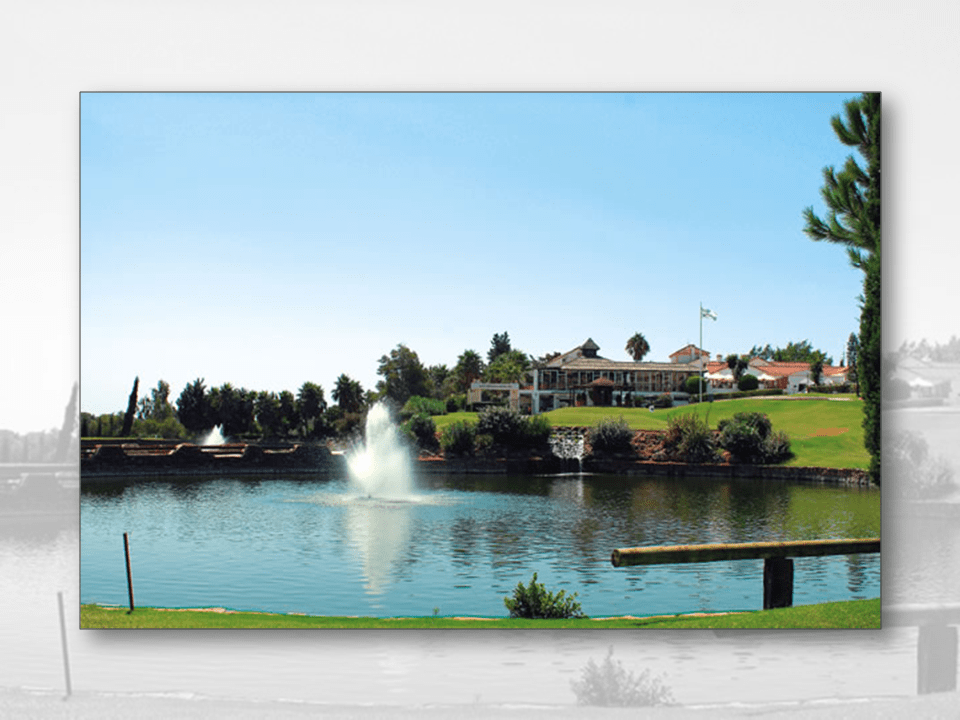 The Santa Maria golf course follows the contours of two valleys and, standing on the first tee, those with a nervous disposition may be all too conscious of a sea of faces watching from the restaurant windows; fear not for the opening par-4 appears more difficult than it actually is. Measuring just 289 metres (all measurements from yellow tees) the apprehension is caused by the water hazard yawning in front but all that is required is a gentle 3-wood, preferably hit straight, onto a generous and tree-lined fairway which slopes from right to left. The tee shot that must be avoided is a hook which will wind up in the water hazard down the left. The large circular green is well bunkered on the front while another lurks at the back left. An approach over-hit could well ricochet off some gnarled old olive trees and disappear into oblivion.
The Santa Maria golf course follows the contours of two valleys and, standing on the first tee, those with a nervous disposition may be all too conscious of a sea of faces watching from the restaurant windows; fear not for the opening par-4 appears more difficult than it actually is. Measuring just 289 metres (all measurements from yellow tees) the apprehension is caused by the water hazard yawning in front but all that is required is a gentle 3-wood, preferably hit straight, onto a generous and tree-lined fairway which slopes from right to left. The tee shot that must be avoided is a hook which will wind up in the water hazard down the left. The large circular green is well bunkered on the front while another lurks at the back left. An approach over-hit could well ricochet off some gnarled old olive trees and disappear into oblivion.
The first section of the fairway on the par-5 second is flat after which it turns to the right and meanders downhill, where care must be taken to avoid not only a tree but also a fair sized bunker situated in a hollow. About 130 metres from the green a hazard eats across the fairway leaving just a narrow pathway through, after which it opens up again and eases its way uphill onto a long but narrow green.
The par-4 third is sandwiched between the two opening holes and merits a rating of index 1. The drive is onto a fairway rising gradually upwards and the further it goes the narrower it gets. The slopes on the right will tend to kick the ball back onto the fairway while the opposite side is well bunkered. The narrow entrance to the good sized green is well guarded on either side by bunkers and more sand awaits at the back. While there is ample room on the right, an approach missing on the opposite side will trundle downwards and probably come to rest on the first green.
There is a good hike to the fourth tee, past some very colourful oleander, and the par-4, measuring 250 metres, is probably the weakest hole on the golf course. The narrow fairway, with a water hazard running the entire length of left-hand side and OB posts on the right, opens out considerably before it reaches a plateau-type green which is wide but shallow and has a bunker below its surface on the left. Although I realise it would reduce the par of the course to 69, I have always felt that this would be a far better hole if it were shortened into a par-3.
The fifth is another short par-4 (294 metres) where a sliced tee shot will disappear into places best avoided. An iron off the tee (up the left) will leave just a pitch to a small green.
Standing on the tee of the par-4 sixth the welcome sight is of an enormous fairway stretching out endlessly which offers the first opportunity to open the shoulders and give the ball a good thump. The fairway, which rises steeply, also slopes from right to left and the buggy path is lined with delightful oleander in full bloom. With not the slightest hint of construction visible the feeling, at last, is of being out in the country. The good sized green is circular but a tree in the left-hand corner may well block an approach shot from that side.
The seventh is a delightful par-3 played across a valley onto a well bunkered, good sized green which has a small step towards the back.
The fairway of the par-5 eighth dog-legs to the right about 220 metres from the tee and any attempt to cut the corner offers little but trouble. A hazard runs up the left but a lake (the home of some huge carp which were thrashing the water as I strolled by) on the opposite side should not present any problem. May the Golfing Gods forgive such flippancy! It should be noted that the red posts lining the hazard on the left suddenly become white as they reach the putting surface, so a hook is not a good idea. Although there is a fair bit of room behind the green a ball bounding through will topple down a steep incline and disappear forever.
Water laps at the feet on the tee of the final hole on the outward journey, a par-4 measuring 302 metres. The drive must carry about 140 metres across water before it reaches the sanctuary of a generous fairway rising sharply. While a couple of bunkers guard the right-hand side they are a better option than the opposite side which offers nothing other than a drop from a hazard. The elevated green is bunkered on the left-front and back and is long but narrow.
The 10th is a par-3 measuring 141 metres and is played from an elevated tee across a valley onto a huge kidney dish shaped green that slopes from back to front. The putting surface is guarded by bunkers on both sides and, as it is 40 metres deep, the flag position will have considerable influence on the choice of club used from the tee.
Although on the short side (286 metres) the par-4 11th is one which can wreck a good card in the making. Standing on the tee the view is of a small parcel of fairway below in a valley with a lake in the background. The fairway then turns left behind some trees and heads towards the green. A player who manages to carry the corner (over high trees) will be left with just a simple pitch to a pear shaped green bunkered at the front and back. Beside the green on the right is a small lake which is fed by the tumbling water of a delightful waterfall.
Behind the 12th tee a small pathway gives access to a platform which provides the most stunning views in all directions but especially back towards the mountains. This is the heart of the countryside and the feeling of tranquillity would bring peace to the most tortured soul. The par-3 hole measures 147 metres and the vegetation growing out of a chasm on the right of the tee is approaching the height which almost blocks out sight of the green. The good sized green is well bunkered on a hole which will not remain long in the memory bank.
The tee shot on the par-5 13th is somewhat daunting as it is played from an elevated tee across a tree filled chasm. The fairway is very generous and a drive up the left-hand side will tend to shorten the hole. Again the buggy path is lined with oleander and what a difference it makes to the appearance of a golf course when the awful sight of concrete paths is eased with spectacular colour. Some 200 metres out the fairway dog-legs sharply left, dips down into a hollow, and then rises up to a green nicely framed by trees which rise up in the background until they stand against the skyline.
The 14th is played from an elevated tee onto a fairway which slopes from left to right and due attention should be given to the OB posts on the left. Just after the 250-metre marker the fairway turns right and dives downwards onto a long but narrow green bunkered on the left and at the back.
The 15th is a par-3 measuring 154 metres played, yet again, from an elevated tee onto a somewhat heart-shaped green which is so far below it seems no bigger than a postage stamp. There is a considerable amount of sand short of the green on this very picturesque hole.
Sixty-four steps, made from railway sleepers, lead up to the platform tee of the par-4 16th on which a relatively narrow tree-lined fairway zigzags its way into the distance. After about 230 metres the fairway widens somewhat and then drops down before rising again onto the putting surface which has two bunkers below the level of its surface on the left. The green is set at an angle to the fairway and, although only 11 metres in width, is 42 metres long.
The par 3 17th measures 151 metres and the only tee shot to be avoided is a hook. The circular green slopes from back to front and presents a good sized target.
The tee shot on the final hole is played out through an avenue of trees onto a narrow strip of fairway which opens out after 200 metres. A hazard runs up the left-hand side but that is not as terminal as diving over the ominous white posts which line the opposite side. The fairway rises gently onto a rectangular shaped green which has a plateau on the back right-hand corner. There is a bunker on the left but ample room at the back.
Despite the August heat, Santa Maria was remarkably busy on the day I played but the reason for the number of golfers became more and more obvious as I made my way around the carefully manicured golf course. The presentation of the course, and the attention given to small details on its surrounds, is little short of perfect and a great credit to the greenkeeping staff.
Santa Maria boasts a considerable number of members but the management, recognising the absolute necessity of income from green fee guests, takes great pride in the courtesy extended to the visitors. It has all the attributes of a successful golf club and its attitude to visiting golfers should serve as a lesson to a minority of other clubs who fail miserably in that regard.
I might add a note of caution if you are travelling to the golf course by car. The sleeping policemen on the approach roads are of rather corpulent proportions and should you drive over them too speedily the underside of your car might well be removed. Forewarned is forearmed!
Golf Spaces Magazine Web

